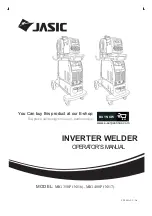
Page 19
- 13 -
these are very important for better operation of the welder and longer service life of the welder.
2
)
No overload
!
Operators should bear in mind that maximum permissible load current (relative to the selected
load duration factor) be observed at any time and welding current should never surpass the
maximum permissible load current.
Over-current will shorten the service life of the welder remarkably and even burn it down.
3
)
No over-voltage
!
Power voltage is shown in the main performance parameter table. In general, the voltage
auto-compensation circuit in the welder will ensure the welding current remain within the
permissible range. If power voltage surpasses the permissible value, the welder will be broken
down. Operators should fully know this and adopt corresponding preventive measures.
4
)
Behind each welder there is a grounding screw with the grounding mark. Before operation the shell
of the welder should be grounded reliably by a cable wire with a sectional area bigger than 6mm
2
so as to release static electricity or prevent any accident due to leakage.
5
)
If the welding machine exceeds the standard load duration factor in operation, it may probably go
into a protective state suddenly and stop work, which indicates it has exceeded the standard load
duration factor. Excessive heating triggers the temperature control switch and makes the welding
machine stop operation. Under such circumstances you needn’t turn off the power so that the
cooling fan may work continuously for cooling. When the temperature drops to the standard
range, welding may be restarted.
12
、
Troubles may be encountered in welding
Phenomena enumerated here may have something to do with the parts, gas, environmental factors
and power supply you use and efforts should be made in improving the environment to avoid
occurrence of such cases.
A
、
Black welding spot
——This shows the welding spot is oxidized without being protected effectively and you can
make the following inspection
:
1. Make sure that the valve of argon cylinder has been opened with sufficient pressure. As a rule, if
the pressure within the cylinder is lower than 0.5MPa, then it is necessary to refill the cylinder.
2. Check if the argon flow-meter is turned on with sufficient flow. You can select different flow rates
in light of varying welding current, but too small flow may lead to inadequate gas stiffness and
thus failure to cover all the welded spots. We suggest argon flow should never be lower than
3l/min no matter how weak the current will be.
3. The easiest way to check gas delivery is to touch the nozzle of welding torch to see whether the





































